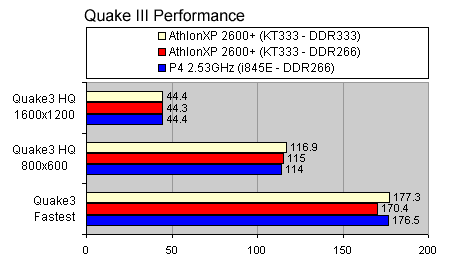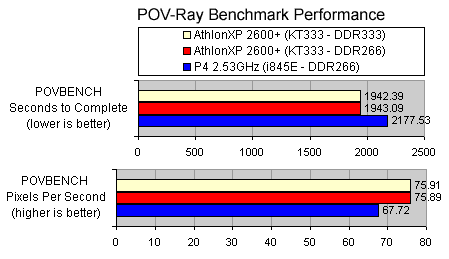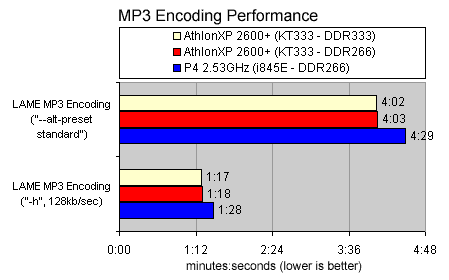|
|
Advertisement:
|
|
AMD AthlonXP Processor 2600+ |
|
Join the community - in the OCAU Forums!
|
Benchmarks Continued
QuakeIII
id Software's Quake3Arena is still regarded as a useful OpenGL benchmark and a good "real world" gaming benchmark. Defaults were used for the "Fastest" and "High Quality" settings, but for "High Quality 1600x1200" as well as bumping up the resolution from the default 800x600 in the HQ test, we also changed Geometric Detail to Highest and dragged the Texture Detail slider to the maximum setting. Our in-house Slayer demo was used with Quake 1.31.

It's pretty clear that there's not a lot in it. At high resolutions both CPU's seem to max out even this high-end video card. At lower resolutions, the AthlonXP 2600+ is slightly ahead of the Pentium4 2.53GHz, but the difference is very small.
I thought some more computationally-intensive benchmarks would be appropriate. These should allow us to focus more on the computational power of the CPU, with less disturbance from chipset issues like AGP or IDE implementation differences.
POV-ray:
To quote their website: The Persistence of Vision Raytracer is a high-quality, totally free tool for creating stunning three-dimensional graphics. We used the "POV-Ray 3.5 standard benchmark v1.02", which raytraces a large image. The writers estimate this to take 45 minutes on a Pentium4 2GHz. This page notes that 3D graphic hardware, MMX and 3DNow! all have no effect on the benchmark, so it can be considered a reflection (no pun intended) of the sheer mathematical power of a CPU, including cache and memory access.

MP3 Encoding:
Encoding CD audio tracks to MP3 format is another CPU-intensive activity and a common use for high-end CPU's on enthusiast PC's. We used Exact Audio Copy to "rip" the CD track into a .WAV. I needed a nice long track for testing purposes - the track "Echos" from Pink Floyd's "Meddle" CD is ideal, at over 23 minutes long. This produced a .wav file of 242.5MB which would be used for benchmarking. In a system prompt window, we used the LAME encoder v3.92 to encode this WAV file to MP3 format. It was encoded twice on each PC, firstly using the "-h" switch (128kb/sec fixed rate high-quality) and then using the "--alt-preset standard" (very high-quality, variable-rate) settings. The "CPU time" recorded by LAME was noted each time.

Once again it seems that when focussing on CPU power, AMD's new chip has the edge.
|
|
Advertisement:
All original content copyright James Rolfe.
All rights reserved. No reproduction allowed without written permission.
Interested in advertising on OCAU? Contact us for info.
|

|


